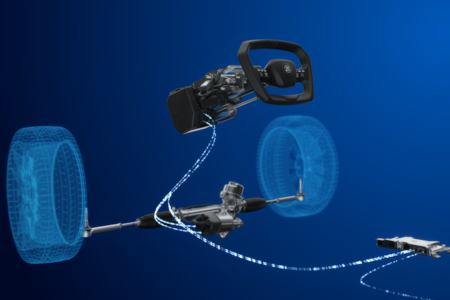A mere four years after starting volume production of its Active Kinematics Control (AKC) rear axle steering system, ZF has become a market leader in the technology, with more than 100,000 units produced to date.
Seven premium vehicle manufacturers have implemented AKC in volume production due to benefits listed as helping electric or conventional passenger cars become more safe, maneuverable and comfortable, with improved dynamics. Automated and autonomous driving are deemed to be considerable growth drivers for ZF’s AKC system in future.
“Our production milestone of 100,000 AKC systems is a huge success in four different respects,” stated Dr Holger Klein, EVP of the car chassis technology division at ZF. “First of all, it illustrates that our innovation allows almost any vehicle to benefit relatively easily from active rear axle steering. Secondly, ZF cements its position as market leader and technology leader in this product segment. Thirdly, every AKC unit installed depicts the forward-looking potential of intelligent mechanical systems in the automotive industry. And last but not least, this milestone highlights the exemplary transformation of the ZF production location in Lebring.”
The site, which is located close to Graz, has been transformed from an axle assembly plant to a hub for high-tech mechatronics and is currently the company’s only AKC production site.
Two concepts for different axle designs
The 100,000 AKC systems produced to date include 60,000 central actuator systems and 40,000 dual-actuator systems. The latter always have two actuators, one on each rear wheel. This version celebrated its premiere in series production in 2013 in the Porsche 911 Turbo and 911 GT3 models. The Ferrari GTC4Lusso also carries the dual-actuator version. Other vehicles, such as the Porsche Panamera, feature the version with a single, larger actuator, which is located in the middle of the rear axle. This system also helps steer the rear of SUVs like the Audi Q7 and sedans like the Cadillac CT6 and the BMW 7 Series.
ZF believes the AKC system still has many more applications and anticipates that in the near future, the system could find its place in many more models with a growing number of manufacturers including pick-up trucks and compact cars. AKC can be combined with every type of drive system, from conventional internal combustion engines to hybrids and all-electric systems, according to ZF.
How AKC works
When driving slowly through narrow streets, AKC steers contrary to the front wheels’ steering angle and generates a higher yaw rate for the vehicle. This can reduce the turning radius by up to 10%, so a passenger car becomes easier to maneuver. At higher speeds of about 40mph (60km/h) and above, as well as during obstacle-avoidance maneuvers for example, the system steers the rear wheels in the same direction as the front wheels, which improves directional stability and driving dynamics.
Ready for the car of tomorrow
ZF says that the active rear track adjustment of the AKC is suited to all current and upcoming megatrends in the automotive industry. It improves safety, especially in critical driving situations and when braking and is an efficient ‘by wire’ system based on the ‘power on demand’ principle. Furthermore, AKC supports automated driving and the necessary system redundancy, as it can partially steer a vehicle without turning the front wheels.
ZF has set high sales expectations for AKC, as Peter Buckermann, head of the company’s mechatronic systems product line stated: “In 2014, the first full production year, approximately 12,000 AKC systems left our production lines and over 100,000 units have been produced to date. In the coming years, we plan to increase production volumes to more than 250,000 units per year.”




